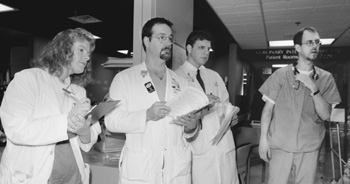Eskind librarians make move from the stacks to the bedside

Eskind's Kimbra Wilder (left) recently assisted Drs. Keith Coffee, Tim Blackwell and Dan Fox. (photo by Anne Rayner)
Eskind Biomedical Library health sciences librarians are taking part in patient rounds at Vanderbilt University Hospital, using their skills as knowledge workers to augment the hospital's intensive care teams.
As full members of the teams, their role is to tackle the unresolved questions about treatment that often crop up by sifting through the relevant literature to quickly retrieve the most pertinent and authoritative studies.
"When I'm busy I don't need to be handed 300 references, I need the three best," said Dr. Nunzia B. Giuse, associate professor of Biomedical Informatics and director of Eskind. Giuse developed and now leads the program, dubbed the clinical informatics consult service. The service is funded completely by Eskind.
"We don't ask for a bibliography," said Dr. John A. Morris, professor of Surgery and director of the Trauma patient care center. "We're asking what are we going to do for these patients. We don't view clinical librarians as 'handy;' we view them as integral to teaching and quality of care."
Morris estimates that the trauma team requests three literature searches per week, and that as many as 10 to 15 percent of these searches lead to changes in VUMC trauma practices.
Beyond regular coaching from Giuse and expertise gained through patient rounds, the librarians further their clinical understanding by attending relevant courses and lectures at the schools of Nursing and Medicine.
The clinical librarians evaluate articles not only for their bearing on the question at hand, but also for soundness of investigative and statistical methods. From the most promising citations, they proceed to scan full articles, sometimes as many as 50, settling finally on no more than three studies. If the search uncovers significant disagreements regarding treatment, the librarians take pains to include competing views. They highlight the texts, write a summary based on highlighted passages, and at the next day's rounds present the results to the team and distribute copies of the summary. The trauma service takes the further step of posting the questions and answers on a web page.
"This library and this program are state-of-the-art," said Dr. John P. Greer, associate professor of Medicine and Pediatrics. "The amount of information available now is extensive; it really pays to have someone helping you."
For example, some bone marrow transplant patients, a librarian provided information that led to a changed chemotherapy regimen in cases of engraftment syndrome, a sometimes dangerous complication. The librarian is now helping the team resolve whether the transplant literature holds evidence regarding optimum timing for harvesting and storing stem cells for later transplant.
The program's clinical librarians include Kimbra Wilder, critical care medicine and bone marrow transplant; Sandra Martin, neonatal intensive care; Marcia Epelbaum, pediatric intensive care; Elizabeth McKinney de Garcia, cardiac intensive care; Rebecca Jerome, trauma and surgical intensive care.
All clinicians on the patient care team are asked to complete a 10-question evaluation of the program at the end of each month's rotation. From July 1997 to November 1998, out of a possible 10 points, the program scored a 9.4 for "overall usefulness."
Eskind plans to expand the program in the coming fiscal year. For more information, contact Kimbra Wilder at 6-3459.













